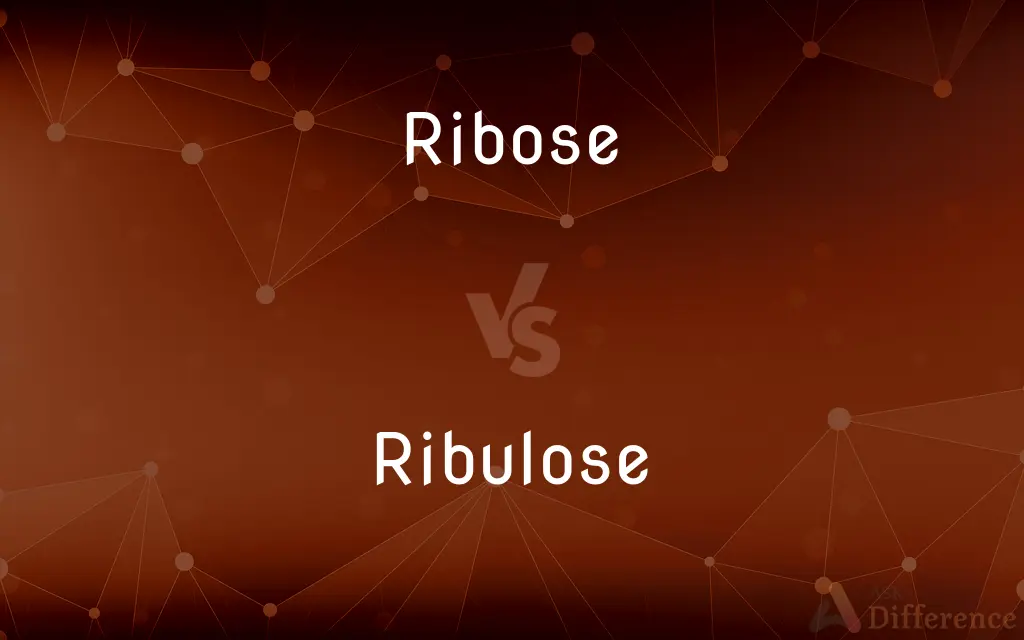Ribose vs. Ribulose — What's the Difference?
By Maham Liaqat & Fiza Rafique — Updated on March 24, 2024
Ribose is a 5-carbon sugar crucial in RNA and ATP formation, offering structural rigidity, while ribulose plays a key role in photosynthesis and carbon fixation, showcasing versatility in energy conversion processes.

Difference Between Ribose and Ribulose
Table of Contents
ADVERTISEMENT
Key Differences
Ribose is a monosaccharide with a pentose (5-carbon) sugar structure, vital for forming RNA and ATP, molecules essential for genetic information transmission and energy transfer in cells. Whereas, ribulose also a pentose sugar, primarily functions within the Calvin cycle of photosynthesis, acting as a carbon dioxide acceptor to aid in energy storage as glucose.
The structure of ribose, with all hydroxyl groups on the same side, makes it an ideal component for the backbone of RNA, providing the necessary stability for the formation of helical structures. On the other hand, ribulose's arrangement allows it to participate actively in the enzyme-mediated processes of carbon fixation, demonstrating its flexibility in biological functions.
Ribose is crucial for the synthesis of nucleotides and nucleic acids, being a building block for RNA and, through conversion, for DNA as well. Ribulose, however, plays a pivotal role in the regeneration of RuBP (ribulose-1,5-bisphosphate) in the Calvin cycle, essential for photosynthetic organisms to synthesize organic compounds from carbon dioxide.
In metabolic pathways, ribose is synthesized through the pentose phosphate pathway, a critical pathway for generating NADPH and pentoses, including ribose itself, necessary for various anabolic reactions. Ribulose, however, is synthesized and utilized within the chloroplasts of plants, highlighting its specific role in the context of photosynthesis and carbon fixation.
Despite their structural similarities, the functions of ribose and ribulose diverge significantly, with ribose being integral to genetic material structure and energy transactions, while ribulose is indispensable in the global process of carbon fixation and the biosynthesis of organic compounds from inorganic carbon sources.
ADVERTISEMENT
Comparison Chart
Primary Function
Structural component in RNA and ATP
Carbon dioxide acceptor in photosynthesis
Structure
All hydroxyl groups on the same side
Arrangement allows flexibility in enzyme reactions
Role in Metabolism
Synthesis of nucleotides and nucleic acids
Regeneration of RuBP in the Calvin cycle
Pathway
Synthesized via the pentose phosphate pathway
Utilized within the Calvin cycle of photosynthesis
Biological Importance
Essential for genetic information transmission and energy transfer
Critical for carbon fixation and glucose synthesis
Compare with Definitions
Ribose
Component of ATP, carrying energy within cells.
Cellular processes are powered by ATP, which contains ribose.
Ribulose
Key in carbon fixation, converting inorganic to organic carbon.
Plants utilize ribulose to synthesize glucose from carbon dioxide.
Ribose
A pentose sugar essential for RNA structure.
Ribose's role in RNA provides the framework for genetic coding.
Ribulose
A pentose sugar involved in photosynthesis.
Ribulose binds with CO2 during the Calvin cycle.
Ribose
Integral to the formation of nucleotides.
Each nucleotide in RNA incorporates a ribose sugar.
Ribulose
Participates in the regeneration of RuBP.
Ribulose is phosphorylated to RuBP, vital for sustaining photosynthesis.
Ribose
Found in coenzymes, aiding enzyme function.
NADH, vital for cellular respiration, includes ribose in its structure.
Ribulose
Found in chloroplasts of photosynthetic organisms.
Ribulose's function is central to the chloroplasts' role in energy conversion.
Ribose
Synthesized through the pentose phosphate pathway.
The body produces ribose for nucleic acid synthesis via this pathway.
Ribulose
Demonstrates the versatility of pentose sugars in biology.
Like ribose, ribulose showcases the functional diversity of sugars in life processes.
Ribose
Ribose is a simple sugar and carbohydrate with molecular formula C5H10O5 and the linear-form composition H−(C=O)−(CHOH)4−H. The naturally-occurring form, d-ribose, is a component of the ribonucleotides from which RNA is built, and so this compound is necessary for coding, decoding, regulation and expression of genes. It has a structural analog, deoxyribose, which is a similarly essential component of DNA. l-ribose is an unnatural sugar that was first prepared by Emil Fischer and Oscar Piloty in 1891.
Ribulose
Ribulose is a ketopentose — a monosaccharide containing five carbon atoms, and including a ketone functional group. It has chemical formula C5H10O5.
Ribose
A pentose sugar, C5H10O5, that is a constituent of RNA and of certain vitamins and coenzymes.
Ribulose
A ketopentose whose phosphate derivatives participate in photosynthesis
Ribose
(carbohydrate) A naturally occurring pentose sugar, which is a component of the nucleosides and nucleotides that constitute the nucleic acid biopolymer, RNA. It is also found in riboflavin.
Ribose
A pentose sugar important as a component of ribonucleic acid
Common Curiosities
Why is ribose important in ATP?
Ribose forms part of the ATP molecule, facilitating energy transfer within cells for metabolic processes.
What role does ribulose play in photosynthesis?
Ribulose acts as a CO2 acceptor in the Calvin cycle, essential for synthesizing glucose from carbon dioxide in photosynthesis.
What is the Calvin cycle, and how does ribulose participate in it?
The Calvin cycle is a series of biochemical reactions in photosynthesis for carbon fixation; ribulose serves as the substrate for RuBP regeneration, crucial for the cycle to continue.
What distinguishes ribose from ribulose?
Ribose is primarily involved in genetic material and energy transfer, whereas ribulose plays a crucial role in photosynthesis and carbon fixation.
How are ribose and ribulose synthesized?
Ribose is synthesized through the pentose phosphate pathway, while ribulose is synthesized and utilized in the Calvin cycle of photosynthesis.
How does ribulose aid in carbon fixation?
Ribulose binds with carbon dioxide in the Calvin cycle, enabling the synthesis of organic compounds from inorganic carbon.
What makes ribose essential for life?
Ribose's role in forming RNA and ATP is fundamental for genetic information flow and energy transfer in living cells.
Is ribose only found in RNA?
While prominent in RNA, ribose is also a component of ATP, NADH, and other crucial biomolecules.
Can the functions of ribose and ribulose overlap in biological systems?
While they serve distinct primary functions, the interconversion of sugars in cells allows for flexibility in their roles.
What is the significance of ribulose in the global carbon cycle?
Ribulose's role in photosynthesis and carbon fixation is vital for converting atmospheric CO2 into organic forms, impacting the global carbon cycle.
How does ribose contribute to RNA structure?
Ribose provides stability for RNA's helical structure, enabling genetic information coding and transmission.
Can ribose and ribulose convert into each other?
In biological systems, enzymes can convert between different sugars, including ribose and ribulose, depending on the cellular requirements.
Do ribose and ribulose have similar structures?
Both are pentose sugars, but their structures differ in the orientation of hydroxyl groups, affecting their biological roles.
Where in the cell is ribulose primarily found?
Ribulose is primarily found in the chloroplasts of photosynthetic organisms, facilitating its role in the Calvin cycle.
How do the roles of ribose and ribulose reflect their importance in biology?
Ribose is key to genetic integrity and energy transfer, while ribulose's involvement in photosynthesis highlights the diversity and complexity of biological systems.
Share Your Discovery

Previous Comparison
Bail vs. Parole
Next Comparison
Jelly vs. JamAuthor Spotlight
Written by
Maham LiaqatCo-written by
Fiza RafiqueFiza Rafique is a skilled content writer at AskDifference.com, where she meticulously refines and enhances written pieces. Drawing from her vast editorial expertise, Fiza ensures clarity, accuracy, and precision in every article. Passionate about language, she continually seeks to elevate the quality of content for readers worldwide.
















































